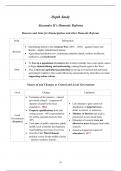Summary
Summary OCR A-Level History, Russia and Its Rulers - Depth Study - Alexander II
- Course
- Institution
OCR A-Level History, Russia and Its Rulers - Depth Study - Alexander II, including reasons and aims for emancipation and domestic reforms, changes to central and local government, living and working conditions, judicial reform, military reform, education reform, industrial change, agricultural chan...
[Show more]



